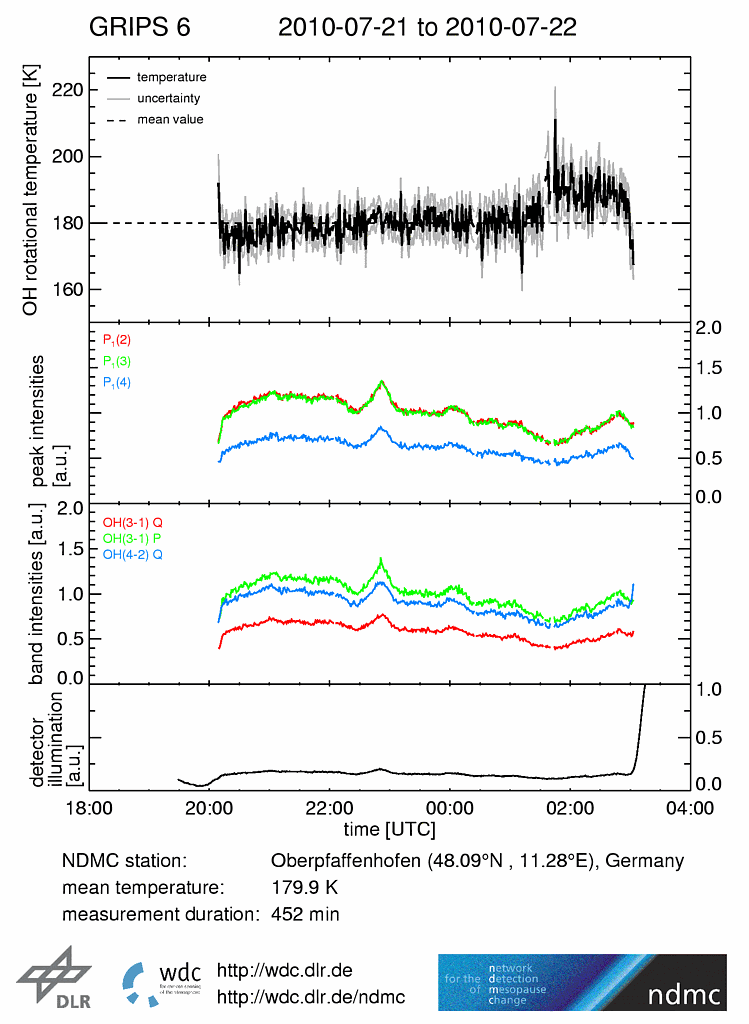NDMC -Station Oberpfaffenhofen: 20 Month of Routine Operations

Since January 2009, the German Remote Sensing Data Center (DFD) of the DLR in Oberpfaffenhofen monitors on a routine basis the night time temperature within the mesopause region. This is made possible by the infrared spectrometer GRIPS 6, which automatically measures night by night the infrared radiation emitted in the atmospheric airglow-layer (appr. 87 km above the Earth’s surface). GRIPS 6 is integrated in the international Network for the Detection of Mesopause Change (NDMC) for monitoring climate signals in this height region. The measured data of GRIPS 6 are automatically submitted to and archived at the World Data Center for Remote Sensing of the Atmosphere (WDC-RSAT) serving as data and communication center for NDMC, where they are available in near real time on the NDMC website as quicklooks (see Figure 2 and Link).

The GRIPS 6 (Ground-based Infrared P-branch Spectrometer) instrument in Oberpfaffenhofen measures the temperature around the mesopause (~87 km). The measurement technique utilizes the so-called airglow: In the upper mesosphere atomic hydrogen reacts with ozone forming excited hydroxyl molecules (OH*) in a layer of ca. 8 km thickness at a peak altitude of approximately 87 km. These chemically excited OH molecules then emit near-infrared radiation from several rotational-vibrational transitions. Emissions around 1.5 µm are measured by the ground-based GRIPS instruments during night time with high precision and high time resolution. The rotational temperature derived from these emissions is directly related to the kinetic temperature in the height of 87 km.
In addition to the GRIPS 6 station in Oberpfaffenhofen, the DLR-DFD also operates a second spectrometer at the Environmental Research Station Schneefernerhaus (Mt. Zugspitze). Both measurement systems are integrated in the Network for the Detection of Mesopause Change (NDMC), an international network of currently 49 globally distributed ground-based measurement stations coordinated by DLR-DFD in cooperation with the Argentine organization CONICET (see Link). The initial emphasis of NDMC is on mesopause region airglow techniques utilizing the existing ground-based and satellite measurement capabilities in order to assess climate change related issues. Because of the low air density and the efficient “cooling-to-space effect’ at this height region, climate signals are expected to be more pronounced at the mesopause level than at lower altitudes, allowing their early detection with high statistical significance. Additional goals of NDMC include the validation of satellite data, the investigations of solar induced changes in the mesosphere, the quantification of small-scale atmospheric motions at the mesopause level for improving the prognostic quality of climate models and the development and sharing of measurement technologies/analysis tools.
NDMC has established a central data archive hosted by the WDC-RSAT, which also acts as a communication platform. As a WMO-GAW affiliated network it builds on and adds value to WMO’s existing observing systems by extending the vertical range of ground-based operations up to the mesosphere and by supporting their interoperability.
